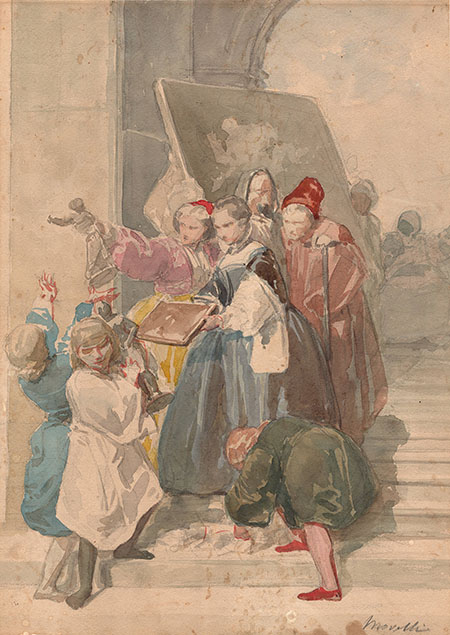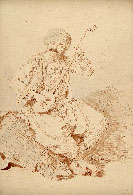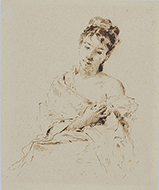(Naples 1826 - 1901)
THE CONFISCATION OF THE PAINTINGS BY SAINT LAZZARO THE ICONOGRAPHER, IN CONSTANTINOPLE
Watercolour over traces in black chalk. Signed Morelli in black chalk lower right. 417 x 302 mm.
Our drawing replicates, in a slight different, less dramatic way, the subject of one of the most famous paintings by Morelli, Gli Iconoclasti, now in Naples at the Gallerie di Capodimonte. That painting (1855) closes Morelli's academic period, and inaugurates, with its great success, the romantic one. Furthermore, the subject expresses the artist's patriotic ideals: through this episode of sacred history Morelli refers to the libertarian and Risorgimento instances expressed and then suffocated in the 1848 movements. The friar is actually a symbol of liberal ideals, while his persecutors allude to the Bourbon guards.
PROVENANCE and LITERATURE: originally the drawing was a sheet of the liber amicorum property of Costanza Bougleux. See Christine Farese Sperken, Luciano Buonanno, Paul Nicholls Omaggi, Marchesa!, Acquerelli e Disegni nell'Album di Costanza Bougleux; catalogue of the exhibition at the IV Biennale Internazionale dell'Antiquariato, Antiquari a Napoli; Naples 1994, cat. no. 56, pag. 82-83, reproduced in colour.
REDUCED PRICE
previous price was € 3800
Alongside Filippo Palizzi, Morelli was the most important artist of the second half of the XIX century in Naples. Morelli enrolled in the Accademia in Naples in 1836 and in 1848 won a fellowship to study in Rome. During the 1850s he visited Florence; under the influence of the historian Pasquale Villari, and inspired by Hayez, he moved to romantic and historical themes. With them he began a phase of verist painting, which he pursued with a trip to Paris for the 1855 Universal Exposition. He returned to Florence to report his observations and to participate in the Macchiaioli discussions. In subsequent years Morelli introduced a vision of reality derived from Palizzi into his historical paintings. Morelli, who was one of the major Neapolitan ottocento artists, had a distinguished academic career, as director of painting, figure, and ornamentation from 1891, and from 1899 president of the Istituto di Belle Arti. Morelli was also an etcher and realized four original prints.




